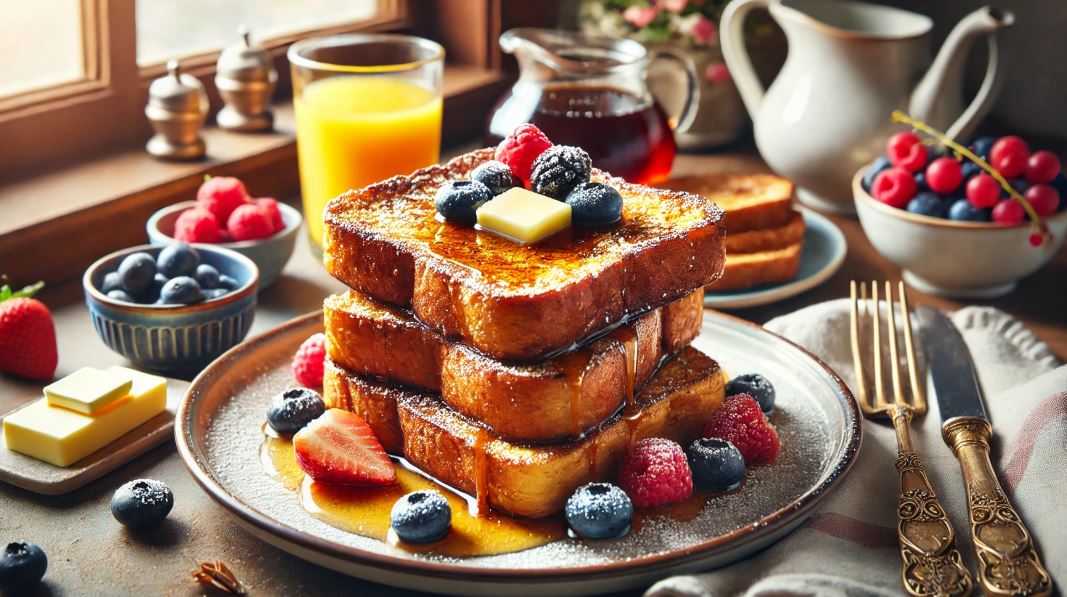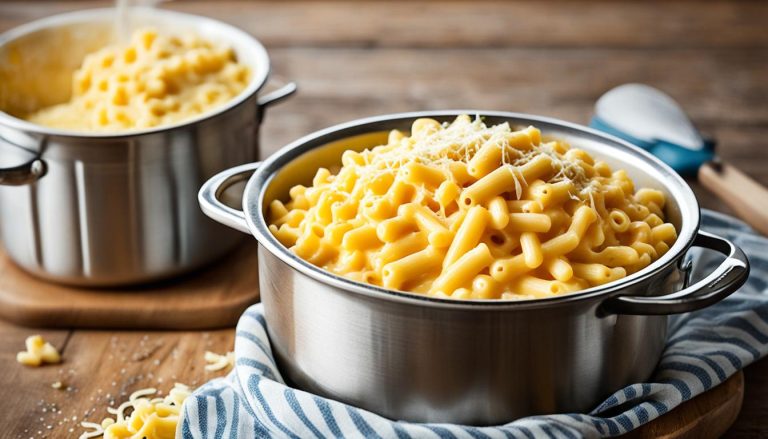As someone who’s spent years exploring breakfast recipes, I can confidently say that French toast remains a timeless favourite.
It’s elegant yet simple, rich in flavour, and incredibly satisfying. Whether you’re preparing a leisurely weekend brunch or a quick weekday treat, this classic dish offers endless potential.
In this guide, I’ll share my personal French toast recipe, tried-and-tested techniques, and chef-inspired variations that elevate it from everyday to exceptional, perfect for anyone seeking a better start to the morning.
What is French Toast?
French toast, often called “eggy bread” in the UK, is a beloved breakfast dish made by soaking slices of bread in a mixture of beaten eggs, milk, and often sugar and spices, then frying them until golden brown. While it’s enjoyed globally today, its origins are quite humble.
A Simple Concept with Universal Appeal
The concept of reviving stale bread by soaking and frying it dates back centuries. The name “French toast” doesn’t necessarily point to France as its origin. In fact, similar versions exist in many cultures:
- Pain Perdu in France means “lost bread,” referring to the use of stale bread
- Arme Ritter in Germany
- Torrija in Spain
This dish has stood the test of time because it’s easy to make, delicious, and incredibly adaptable.
Key Characteristics
- Crispy on the outside, soft and custardy inside
- Sweet or savoury depending on preferences
- Ideal for breakfast, brunch, or even dessert
For me, French toast is more than just a quick meal, it’s a nostalgic comfort food I’ve refined over the years to suit every mood and occasion.
How Did French Toast Become a Breakfast Favourite?
French toast’s journey from medieval Europe to modern-day breakfast tables is both fascinating and flavourful.
Though versions of it have existed for centuries, it gained significant popularity in the UK and across the Western world in the 20th century, largely due to its simplicity and the rise of brunch culture.
From Humble Beginnings to Café Staple
- Middle Ages: Originally designed to use up stale bread and prevent food waste.
- 17th–19th century: Recipes began appearing in cookbooks under names like “poor knights” or “pan perdu.”
- 20th century: The dish was adopted and modified by different cultures, especially in America, where sweet toppings became popular.
Today, cafes and restaurants offer gourmet versions with unique toppings like mascarpone, fruit compotes, or even bacon and maple syrup.
Why It’s So Loved?
- Requires only pantry staples
- Versatile for sweet or savoury preferences
- Quick to prepare with minimal effort
As someone who enjoys a quiet, slow morning, I find French toast the perfect start—quick to whip up but deeply satisfying.
Ingredients for Perfect French Toast
When crafting the perfect French toast, the ingredients play a crucial role in flavour and texture. Below is a precise table detailing the quantities and purpose of each ingredient.
| Ingredient | Quantity | Purpose |
| Eggs | 2 large | Base of the custard mixture |
| Whole milk | 120 ml | Adds richness and moisture |
| Double cream | 30 ml (optional) | For an extra creamy texture |
| Vanilla extract | 1 teaspoon | Enhances sweetness and aroma |
| Ground cinnamon | 1/2 teaspoon | Adds warm spice (optional) |
| Granulated sugar | 1 tablespoon | Light sweetness (can be adjusted) |
| Salt | A pinch | Balances flavours |
| Bread (Brioche/Challah) | 4 slices (thick cut) | Best texture when soaked and fried |
| Butter or oil | 1 tablespoon | For frying; gives a golden crust |
Tips for Best Results
- Use day-old or stale bread for better absorption
- Mix custard gently to avoid froth
- Let the bread soak for at least 20 seconds per side
These are the ingredients I rely on when aiming for that perfect French toast every time.
Step-by-Step Method for Making Fluffy French Toast Recipe
Crafting French toast is a balance of timing, heat, and technique. Here’s my tested process to get it right every time.
Step 1: Prepare the Custard

- Crack the eggs into a mixing bowl
- Add milk, cream (if using), vanilla, sugar, cinnamon, and salt
- Whisk gently until smooth but not frothy
Step 2: Soak the Bread

- Use thick slices of slightly stale bread
- Dip each slice in the custard mixture
- Soak for 20–30 seconds per side until saturated but not falling apart
Step 3: Heat and Cook

- Heat a non-stick pan or griddle over medium-low heat
- Add butter or oil and allow it to melt evenly
- Cook each slice for 2–3 minutes per side until golden brown
Step 4: Serve Immediately

- Place on a plate lined with a paper towel
- Dust with icing sugar or serve with toppings
This process ensures your toast is fluffy on the inside and crisp on the outside, a balance I always aim for.
How Do I Choose the Best Bread for French Toast?
Bread can make or break your French toast. The structure, density, and absorbency matter more than people often realise.
Best Bread Options
- Brioche: My top pick, rich and buttery
- Challah: Slightly sweet and soft, great for soaking
- Sourdough: Adds a unique tang (great for savoury versions)
- White Sandwich Bread: Budget-friendly, but needs to be a day old
What to Avoid?
- Very fresh bread, it falls apart easily
- Thin-sliced or pre-sliced supermarket loaves—they get soggy too fast
In my experience, slicing your own loaf into thick pieces gives you better control over texture.
What Are the Different Chef-Recommended Variations of French Toast?
Various chefs and culinary platforms have their signature takes on this dish. Here’s a round-up of techniques and twists from trusted culinary sources.
BBC Good Food’s Brioche French Toast
- Uses orange zest and cinnamon in the egg mix
- Suggests brioche for its soft and buttery finish
- Topped with seasonal fruit and yoghurt
Simply Recipes’ Classic Method
- Emphasises soaking until saturated
- Uses a mix of milk and cream
- Pan-fried in butter for a crispy crust
Love and Lemons’ Dairy-Free Version
- Uses plant-based milk
- Adds maple syrup to the custard
- Fried in coconut oil for flavour variation
AllRecipes’ Fluffy French Toast
- Whips egg whites separately for extra fluffiness
- Recommends vanilla and nutmeg
- Ideal for those preferring a dessert-like version
Each variation brings a unique texture and flavour, and I’ve enjoyed experimenting with all of them in my kitchen.
Can I Make French Toast Ahead of Time or Store It for Later?
French toast can absolutely be made ahead with a few simple adjustments.
Make-Ahead Tips
- Cook and store slices in an airtight container in the fridge for up to 3 days
- Reheat in a toaster or oven at 180°C for 5–8 minutes
Freezing Instructions
- Let slices cool completely
- Place parchment between slices and freeze
- Reheat from frozen directly in the oven for 10 minutes at 180°C
For busy mornings, I often make a double batch on Sundays and refrigerate or freeze the extras.
What Common Mistakes Should I Avoid When Making French Toast?
Even seasoned home cooks can make a few missteps. Here are some common errors to avoid.
Common Pitfalls
- Using fresh bread: it doesn’t soak properly
- Too much heat: causes burning on the outside while leaving the inside undercooked
- Skipping the salt: it enhances sweetness and balances flavours
- Over-soaking: makes the bread soggy and prone to tearing
How Can I Customise French Toast for Different Diets?
French toast is surprisingly adaptable for dietary needs with just a few substitutions.
Vegan French Toast
- Replace eggs with mashed bananas or flaxseed meal
- Use almond or oat milk
- Cook with plant-based butter or coconut oil
Dairy-Free Version
- Use coconut milk or soy milk
- Omit cream or use a dairy-free alternative
These variations have allowed me to serve French toast to friends with various dietary preferences without sacrificing flavour.
Nutritional Table (Per Serving – Approximate)
| Nutrient | Amount |
| Calories | 310 kcal |
| Protein | 10 g |
| Carbohydrates | 34 g |
| Sugar | 8 g |
| Fat | 15 g |
| Saturated Fat | 7 g |
| Sodium | 210 mg |
| Fibre | 1.5 g |
What Are Some Delicious Toppings and Sides to Serve with French Toast?
Toppings take French toast from good to great. Here are my go-to options:
Sweet Toppings
- Fresh berries or banana slices
- Whipped cream or Greek yoghurt
- Honey, maple syrup, or icing sugar
- Nutella or almond butter
Savoury Options
- Crispy bacon
- Smoked salmon and cream cheese
- Grilled tomatoes or mushrooms
Serving Suggestions
- Serve with fresh orange juice or a latte
- Pair with a light green salad for a brunch twist
- Add nuts and seeds for crunch
Conclusion
French toast is more than just a meal, it’s a celebration of comfort and creativity. From selecting the right bread to mastering the custard soak, each detail plays a role in delivering the perfect bite.
Over the years, I’ve found that with a bit of care and experimentation, this simple dish can become a signature breakfast you’re proud to serve.
I hope my recipe and tips help you craft your own flawless version and make mornings that little bit brighter.
FAQs
What’s the best bread thickness for French toast?
Thick-cut slices (about 1 inch) hold the custard well and cook evenly, offering a better texture than thinner slices.
Can I use gluten-free bread for French toast?
Yes, gluten-free bread works well, especially if it’s slightly stale. Just ensure it’s firm enough to soak without breaking.
Why is my French toast soggy in the centre?
This is often due to over-soaking or high heat. Lower the heat and let the custard cook through.
Is it necessary to add sugar to the egg mixture?
Not always. If you’re using sweet toppings, you can skip or reduce the sugar in the custard.
Can I make French toast without eggs?
Yes, use mashed banana or soaked chia/flax seeds as a binder for an egg-free alternative.
How long should I soak the bread in custard?
Ideally, 20–30 seconds per side. Too short won’t absorb enough, and too long can turn the bread mushy.
Can French toast be baked instead of fried?
Yes, bake at 180°C for 15–20 minutes, flipping once halfway through for a healthier version.

French Toast Recipe
Ingredients
- 2 large Eggs Base of the custard mixture
- 120 ml Whole milk Adds richness and moisture
- 30 ml Double cream optional For an extra creamy texture
- 1 teaspoon Vanilla extract Enhances sweetness and aroma
- 1/2 teaspoon Ground cinnamon Adds warm spice or optional
- 1 tbsp Granulated sugar can be adjusted
- Salt A pinch
- 4 slices Bread Brioche/Challah slices (thick cut) Best texture when soaked and fried
- 1 tbsp Butter or oil For frying; gives a golden crust
Instructions
Step 1: Prepare the Custard
- Crack the eggs into a mixing bowl2 large Eggs
- Add milk, cream (if using), vanilla, sugar, cinnamon, and salt120 ml Whole milk, 30 ml Double cream, 1 teaspoon Vanilla extract, 1/2 teaspoon Ground cinnamon, Salt, 1 tbsp Granulated sugar
- Whisk gently until smooth but not frothy
Step 2: Soak the Bread
- Use thick slices of slightly stale bread4 slices Bread
- Dip each slice in the custard mixture
- Soak for 20–30 seconds per side until saturated but not falling apart
Step 3: Heat and Cook
- Heat a non-stick pan or griddle over medium-low heat
- Add butter or oil and allow it to melt evenly1 tbsp Butter or oil
- Cook each slice for 2–3 minutes per side until golden brown
Step 4: Serve Immediately
- Place on a plate lined with a paper towel
- Dust with icing sugar or serve with toppings









